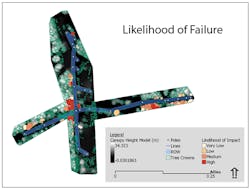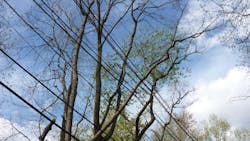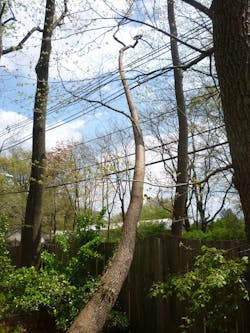The Research of Tree Failure
The International Society of Arboriculture (ISA), which published Best Management Practices for tree risk assessment for general settings, recently released a companion publication for tree risk assessment in the utility setting. The utility tree risk assessment method uses a qualitative, matrix-based risk assessment to assign each the Likelihood of Failure, Likelihood of Impact and Consequences of Impact for a given tree, on a given target and within a given timeframe.
In the utility setting, researchers have used numerous methods to estimate the likelihood of impact for trees along a segment of electrical line, and the resulting consequences can be assigned based on factors such as projected outage duration or frequency, potential for equipment damage, risk to public safety and the customer count downstream of the vegetation being assessed. Yet, it remains difficult to determine each tree’s likelihood of failure and post-outage investigations have made it evident that not all trees exhibit outwardly visible signs of an increased likelihood of failure. In fact, defect-free trees have also caused electrical disruptions.
What Do We Know?
A recent review of the scientific literature provided guidance as to what is known pertaining to tree failures in the utility sector (Walker 2020). This review was funded in part by a grant from Utility Arborist Research Grant Fund Program managed by the TREE Fund.
At the fundamental level, trees fail when the load exerted on them exceeds their biomechanical strength. Yet, the quantification of the actual loading of trees when subjected to storm or even everyday events remains absent from the literature. Even so, wind has been identified as the most prevalent force, which plants must contend with in the terrestrial environment, prompting the use of the word “windthrow” to refer to the process of wind-induced stem breakage or uprooting.
It is anticipated that wind gusts will initiate more failures than a constant wind speed due to the additional crown displacement resulting from dynamic loading. A common threshold for damage to trees is 50 mph, with damage typically limited to breakage of twigs below the threshold and failures of shallow rooted trees above 50 mph. Yet mechanistic studies of trees suggest that tree species will fail within a wind speed range of 22-145 mph, with most species experiencing catastrophic failure by 110 mph.
Utility vegetation management (UVM) programs routinely prune trees to keep the line free of vegetation making direct contact with the facilities, yet this work changes the local wind patterns. Studies have suggested that a wind regiment change due to pruning or removal in the immediate area may increase the likelihood of tree failure.
Additionally, asymmetric trimming led to an increase in mid-crown mechanical stress yet pruning did not increase the likelihood of failure for urban trees. It must be noted that these studies were not directly connected to utility forestry and may differ in terms of pruning scope and resulting dynamic loading potential.
In a post-storm study, tree failure was more strongly correlated with tree height and diameter, and removal of nearby trees was only shown to have a relatively small effect. In short, while we know that pruning along electrical corridors reduces grow-in and other shorter duration outages, much is left to learn as to why whole trees fail especially those trees adjacent to or off right-of-way (ROW).
While precipitation alone rarely causes tree failure, when coupled with wind and other effects, precipitation can possess a deciding role in tree failure. Precipitation type (rain, snow, ice, etc.) plays a role in load interception, where snow and ice can increase interception, particularly during “leaf-on” conditions in deciduous trees. Furthermore, precipitation could exacerbate wind-caused failure rates through soil saturation by decreasing the strength of the soil-root plate and thus increasing the likelihood of windthrow.
Other factors such as soil type, topography and tree species are assumed to have roles in the likelihood of failure, but their exact relationships with failure have yet to be determined. The relationship between failure and tree species is difficult to assess because individual differences in tree structure (co-dominant stems, girdling roots, etc.) may confound differences in species-wide traits (strong wooded, decay resistant etc.).
Furthermore, given the regional differences in tree species, weather patterns, soil types, and topography, it is anticipated that the likelihood of tree failure, too, will have regional differences. Ideally, one could analyze post-outage report investigations to identify failure patterns, yet databases might need to be compiled from multiple utilities to obtain enough data for robust analysis.
How Do We Study Failure?
One challenge researchers have faced in studying the likelihood of failure in trees has been obtaining a large enough sample of tree failures that are sufficiently dispersed across different regions. Utilities are often regional with individuals tasked with monitoring ROW vegetation conditions. Given these circumstances, utilities are uniquely positioned such that they can both aid in, and benefit from a collective tree failure research approach.
The study examined the difference between likelihood and probability. These terms are often used interchangeably but can mean different things. Historical tree failure research uses likelihood as a categorical variable, which complements the ISA Tree Risk Assessment protocols. These approaches place likelihood in categories such as improbable, possible, probable or imminent. While this approach is common and useful, it does not assign a numerical value, i.e. a probability, that could be added in algorithms to predict failure at the system, circuit or device protected line segment level. The authors believe that the development of a numerical probability of failure would advance the industry by identifying hot spots or high-risk areas that could be addressed by managers.
Currently, two primary methods are available for monitoring ROW vegetation conditions: traditional visual patrol and remote sensing. Our research made recommendations using these two primary methods.
The traditional method would make use of visual patrols to gather a sufficient sample size of spans or trees under and adjacent to the electrical ROW in each region and monitor over a long-term (minimum of five years). All failures, whether or not that failure resulted in a sustained outage, would be recorded. This approach would allow the development of a likelihood of failure model. This approach could also be expanded to develop a numerical probability of failure, by initially inventorying all the trees in the study area that could potentially fail and strike the powerlines.
The remote sensing method would entail the acquisition of imagery and/or lidar data of the representative locations at multiple timepoints. Then using “change detection” analysis, researchers can compare the differences between the two timepoints to estimate the number of trees that have failed between the time points. This method could also be designed to yield both a categorical likelihood and/or a numerical probability of failure. One benefit of the remote sensing method is that the necessary data may already exist, as numerous utilities have already adopted remote sensing methods for the monitoring of transmission lines and ROWs. While the required computational time might be a burden for change detection approaches, with recent advances in machine learning this method is rapidly becoming more feasible.
Analyzing the Likelihood of Failure
Vegetation Management is often the largest maintenance expense for many utilities. Due to the large population of trees a utility must manage, tree risk assessment of each individual tree may not be possible due to time and financial constraints. Further, trees located off the immediate ROW that may impact the facilities if they fail, are often ignored or only partially addressed due to both the expense of addressing every tree and a lack of understanding as to their relative potential for failure.
Research has shown that wind, precipitation and tree properties (height, diameter, species, etc.) play roles in the likelihood of failure, but those roles are not clearly defined or understood. Soil type and topography are also expected to have significant roles in the likelihood of failure.
Research related to the likelihood and/or probability of failure of trees in and around ROWs would assist in the development of future tree risk assessment protocols. Furthermore, utilities stand to benefit from research aimed at the development of a baseline tree failure or fall rate(s) (a single rate or multiple regional rates), as these metrics could inform vegetation management managers about the number of tree failures they should expect to experience over a given time. Additionally, this line of research holds promise to illuminate specific factors (tree species or structure, topography, proximity to removals, pruning history, etc.), which could indicate an elevated likelihood of failure.
Matthew Walker is a Ph.D. student in Natural Resource Economics and Management at West Virginia University’s Davis College of Agriculture, Natural Resources and Design. He conducts research in energy and forest resources, remote-sensing and utility vegetation management. He earned his master’s degree in forest resource management from WVU in 2020. Previously he has worked as a contract utility forester for ECI in Morgantown, West Virginia.
Gregory Dahle is an associate professor at West Virginia University. His arboricultural research is focused on finding new ways to remotely identify danger trees both inside and outside of utility ROWs to reduce fall-ins and subsequently power outages. Greg was a practicing utility forester in California and worked as a sales manager for commercial arboriculture company. He is an ISA Board-Certified Master Arborist and Qualified Tree Risk Assessor.
JM Sparkman is the manager of consulting services at Environmental Consultants, LLC. He directs an array of distribution and transmission consulting services at ECI designed to assist electric cooperatives, municipals, and investor-owned utilities with improving their vegetation management programs. He holds a B.S. in Forestry from Virginia Polytechnic Institute and State University. His experience includes more than 32 years of utility vegetation management including research, contract and project management, budgeting, storm logistics and local VM operations.
About the Author
Matthew Walker
Matthew Walker is a Ph.D. student in Natural Resource Economics and Management at West Virginia University’s Davis College of Agriculture, Natural Resources and Design. He conducts research in energy and forest resources, remote-sensing and utility vegetation management. He earned his master’s degree in forest resource management from WVU in 2020. Previously he has worked as a contract utility forester for ECI in Morgantown, West Virginia.
Gregory Dahle
Gregory Dahle is an associate professor at West Virginia University. His arboricultural research is focused on finding new ways to remotely identify danger trees both inside and outside of utility ROWs to reduce fall-ins and subsequently power outages. Greg was a practicing utility forester in California and worked as a sales manager for commercial arboriculture company. He is an ISA Board-Certified Master Arborist and Qualified Tree Risk Assessor.
JM Sparkman
JM Sparkman is the manager of consulting services at Environmental Consultants, LLC. He directs an array of distribution and transmission consulting services at ECI designed to assist electric cooperatives, municipals, and investor-owned utilities with improving their vegetation management programs. He holds a B.S. in Forestry from Virginia Polytechnic Institute and State University. His experience includes more than 32 years of utility vegetation management including research, contract and project management, budgeting, storm logistics and local VM operations.



